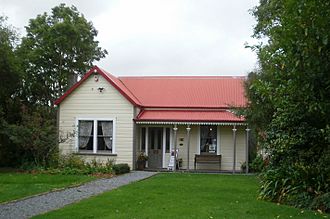Golder Cottage facts for kids
Quick facts for kids Golder Cottage |
|
|---|---|
 |
|
| General information | |
| Type | House |
| Architectural style | Victorian |
| Location | Upper Hutt, New Zealand |
| Coordinates | 41°7′31.85″S 175°3′22.54″E / 41.1255139°S 175.0562611°E |
| Completed | 1876 |
| Designated: | 1991 |
| Reference #: | 2891 |
Golder Cottage is a very old house in Upper Hutt, New Zealand. It is one of the oldest homes still standing from the early days of European settlement. Today, this special house is a museum. It helps people understand what daily life was like for families long ago.
Contents
A Home from the Past
Building a Family Home
The Golder Cottage was built by a man named John Golder. He was a road builder in Wellington. He finished building the cottage around 1876 or 1877.
Around the same time, John Golder married Jane Martin. They moved into the cottage and started their family. John and Jane raised 12 children in this house. Imagine how busy and full of life it must have been!
Over a Century of History
The Golder family lived in this cottage for more than 100 years. It stayed in their family for many generations. This is quite rare for a house.
Eventually, the Upper Hutt City Council bought the property. This meant the house would be protected. It would not be torn down or changed too much.
The Cottage as a Museum
After the council bought the cottage, the Golder's Homestead Museum Society took over. This group worked hard to fix up the old house. They wanted to make it look like it did when the Golder family lived there.
Now, Golder Cottage is a museum. Visitors can explore the rooms and see old furniture. It helps people learn about colonial domestic life. This means learning about how families lived in New Zealand during the colonial period.
See also
- List of historic places in Upper Hutt

